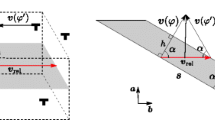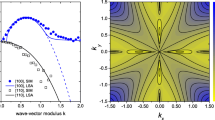Abstract
A new model of recovery-controlled creep deformation, based on the jerky glide motion of dislocations between obstacles, is proposed. A three-dimensional distribution of dislocation links is visualized such that only links which attain a certain threshold size,λ a, through recovery can glide rapidly until they are again arrested at the next obstacle. The rate of mobilization of arrested dislocations is shown to be directly proportional to the annihilation rate, ϱa. The strain rate, γ, during transient creep is related to the annihilation rate, the obstacle spacingL and the Burgers vectorb of the dislocations according to the expression
where α1 is a geometrical constant and ψ(t) is a time-dependent parameter whose value is determined by the instantaneous (free) dislocation density as well as some salient features of the dislocation distribution. At steady state, ψ(t) translates into a constant which is stress and temperature independent. The average effective dislocation velocity is also shown to be directly proportional to the annihilation rate. The model is used to rationalize the familiar creep transients which are usually observed when the stress is altered abruptly during recovery creep.
Similar content being viewed by others
References
C. R. Barrett, W. D. Nix andO. D. Sherby,Trans. ASM 59 (1966) 3.
O. D. Sherby, R. H. Klundt andA. K. Miller,Met. Trans. 8A (1977) 843.
O. Ajaja andA. J. Ardell,Phil. Mag. A39 (1979) 65.
J. L. Adelus, V. Guttman andV. D. Scott,Mater. Sci. Eng. 44 (1980) 195.
C. N. Ahlquist andW. D. Nix,Acta Metall. 19 (1971) 373.
R. Horiuchi andM. Otsuka,Trans. Jpn Inst. Metals. 13 (1972) 284.
E. Orowan,J. West Scotland Iron Steel Inst. 54 (1946) 45.
W. J. Evans andB. Wilshire,Met. Sci. J. 4 (1970) 89.
T. H. Alden,Metall. Trans. 8A (1977) 1857.
P. Ostrom andR. Lagneborg,J. Eng. Mater. Tech. (Trans. ASME Series H)98 (1976) 114.
P. P. Gillis, J. J. Gilman andJ. W. Taylor,Phil. Mag. 20 (1969) 279.
D. J. Lloyd, P. J. Worthington andJ. D. Embury,ibid. 22 (1970) 1147.
H. J. Frost andM. F. Ashby,J. Appl. Phys. 42 (1971) 5273.
U. F. Kocks, A. S. Argon andM. F. Ashby,Prag. Mater. Sci. 19 (1975) 68.
H. Mecking andK. Lucke,Scripta Metall. 4 (1970) 427.
R. Lagneborg andB. -H. Forsen,Acta Metall. 21 (1973) 781.
A. Oden, E. Lind andR. Lagneborg, in Proceedings of the Meeting on Creep Strength in Steel and High Temperature Alloys, Sheffield, 1972 (Iron and Steel Institute), p. 60.
A. J.Ardell and M. A.Przystupa,Mech. Mater., in press.
U. F. Kocks andH. Mecking,J. Eng. Mater. Tech., (Trans. ASME Series H)98 (1976) 114.
W. Blum,Phys. Status Solidi (b) 45 (1971) 561.
J. Hausselt andW. Blum,Acta Metall. 24 (1976) 1027.
H. Oikawa, M. Maeda andS. Karashima,Scripta Metall. 6 (1972) 339.
V. Pontikis,Acta Metall. 25 (1977) 847.
J. P. Poirier,ibid. 25 (1977) 913.
T. Hasegawa, T. Yakov andU. F. Kocks,ibid. 30 (1982) 235.
V. K. Sikka, H. Nahm andJ. Moteff,Mater. Sci. Eng. 20 (1975) 55.
R. Gasca-Neri, C. N. Ahlquist andW. D. Nix,Acta Metall. 18 (1970) 655.
O. Ajaja,Scripta Metall. 15 (1981) 975.
Author information
Authors and Affiliations
Rights and permissions
About this article
Cite this article
Ajaja, O. A dislocation network model of recovery-controlled creep. J Mater Sci 21, 3351–3356 (1986). https://doi.org/10.1007/BF00553380
Received:
Accepted:
Issue Date:
DOI: https://doi.org/10.1007/BF00553380




